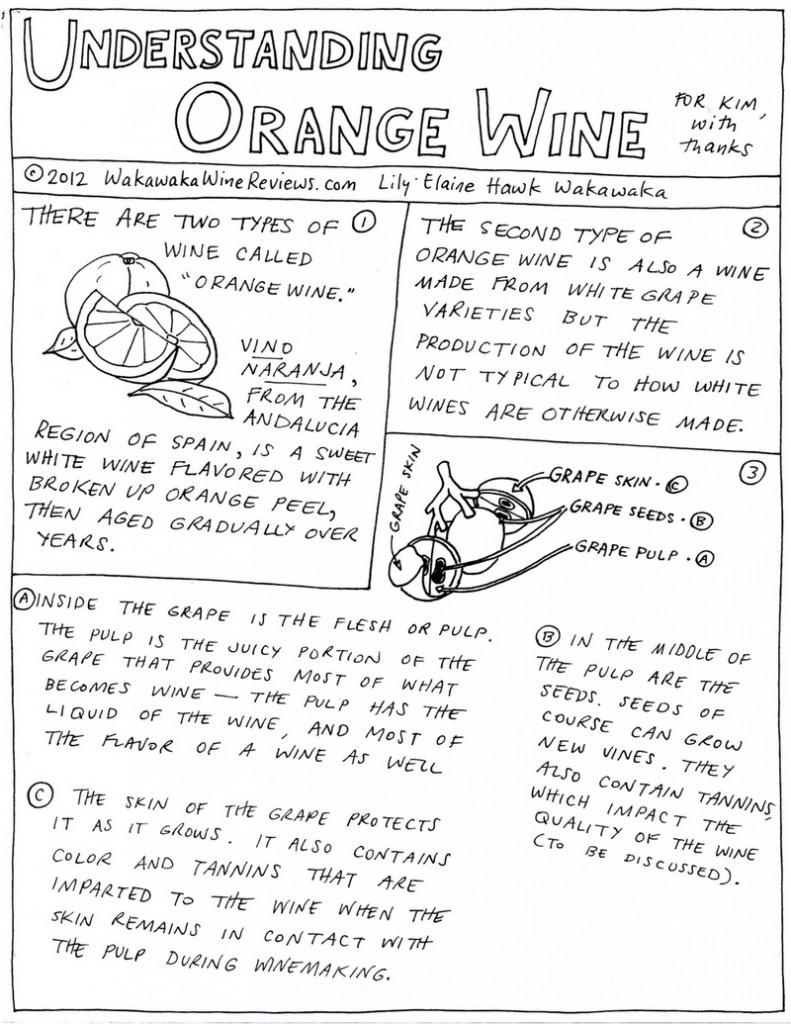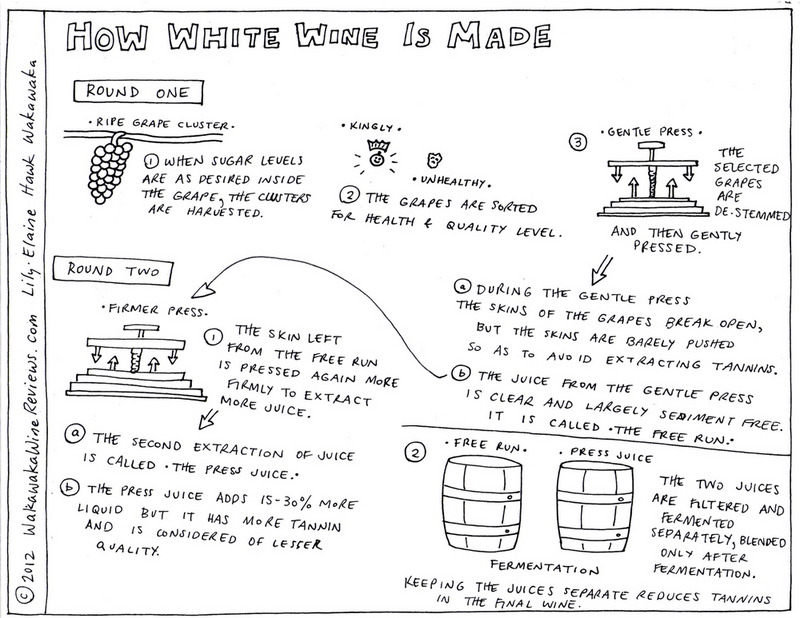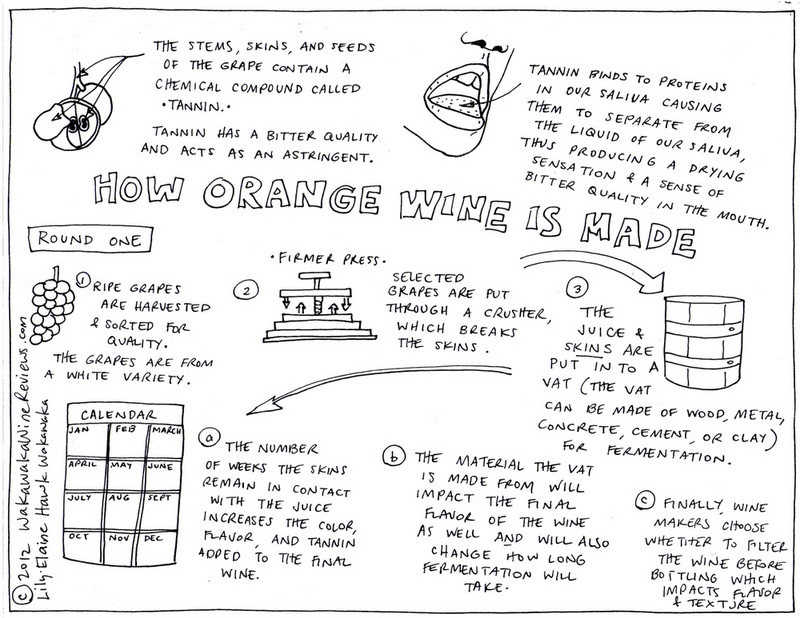Kim wrote and asked if I would do a feature on Orange Wine. She’d read about the phenomenon online and hoped I’d take some time both to explain what the heck orange wine is, and also to review some orange wines. Thanks so much for asking, Kim, and I’m so happy to do a feature on the subject for you!
So, today we’ll cover both the general process through which orange wines are made, and the basic qualities of grapes that get presented differently in the orange wine making process, and thus make tasting orange wines interesting.
Next week we’ll look at a whole series of orange wines from various parts of the world, reviewing the tasting notes of each, and the more specific story of how each are made.
click on comic to enlarge
Knowing these points about the basic parts of the grape–the skin, seeds, and pulp–will help explain what is importantly different between a typical white wine, and an orange wine of the second sort. (Though I would eventually like to taste a Vino Naranja and admit I haven’t gotten to do so yet. For those wine geeks that are interested in such things–vino naranja is aged in a solera method and as a result shows qualities like sherry. The rest of this post ignores vino naranja and assumes that the designation “orange wine” refers to the second version of this designation.)
So, first, let’s look at the quick and dirty basics of how a white wine is typically made these days.
click on comic to enlarge
In white wine production the skin is quickly separated from the bulk of the juice. Though the skins are then pressed again to gain more juice from the grape, the liquid from the first press, and that from the second are kept separate during fermentation. In this way, the wine maker can then carefully select the right proportion for mixing to create the final bottled wine. By keeping the first and second press juice separate the wine maker is also able to reduce the color, and tannin influence in the wine. In both, the skins are kept away from the fermentation process, and the seeds are filtered out of the liquid before fermentation as well.
The reasons for keeping the skins and seeds separate from the liquid rest primarily in the flavor and textural effect they impart to the wine. Understanding how the tannins present in the skin, seeds, and stems impacts the quality of the wine will better show the difference between a wine made with their influence and a wine made without their influence.
An orange wine is made with a white grape variety, but in a process more like how red wine is typically made.
click on comic to enlarge
Though orange wines are made with white grape varieties, because orange wines are produced in a manner more like how red wines are made, orange wines have textural and structural qualities closer to a red than to a white wine. While the free run and the press juice are kept separate in white wine production, in orange wines there is only the initial pressing done firmly and then skins are fermented within the juice. In this way the skins impart both color and tannin to the wine. The richer color quality of the wine caused by the skin is where the designation “orange wine” originates.
The basic commonality of orange wine production is the extended contact of the skin with the juice. However, different orange wine producers vary other aspects of the production process, most notably how long the skin contact continues. For some wine makers, the skin contact is as little as several days, while for others it continues for several months. Besides the choice of extended skin contact, orange wine producers also differ in the type of fermentation vessel used. This aspect of orange wine production will be considered further next week when we review specific orange wines.
Because of the extended skin contact, orange wines not only have a richer color quality, they also have higher tannin content than typical white wines, while still showing many of the sort of fruit and floral tasting characteristics of a white. As a result, many consider orange wines a difficult food pairing challenge. Tannins create a textural quality in wine that feels both drying and bitter in the mouth, and changes how we experience the flavors of whatever we are tasting, be it wine or food.
Since white wines are produced to keep them sediment free and tannin low, we experience not only their particular grape profile but also a different textural quality than wines made in a red wine fashion. Orange wines, retain their particular white grape profile but gain the structure of a red wine. But also, with the higher tannin levels of the orange wine, the grape’s flavor profile does shift some what along with the texture. Interestingly, in fully blind tastings (where the wines literally could not be seen in the glass) orange wines have actually been mistaken as reds.
***
To read the rest of this series, follow these links:
Understanding Orange Wines 2: Georgian Amber Wines: Pheasant’s Tears Rkatsiteli, Vinoterra Kisi: http://wakawakawinereviews.com/2012/02/20/understanding-orange-wines-2-georgian-amber-wines-pheasants-tears-rkatsiteli-vinoterra-kisi/
Understanding Orange Wines 3: Italian Orange Wines: Gravner Breg, Vodopivec Classica, Bea Arboreus, Coenobium Rusticum: http://wakawakawinereviews.com/2012/02/23/understanding-orange-wines-3-italian-orange-wines-gravner-breg-vodopivec-classica-bea-arboreus-coenobium-rusticum/
Understanding Orange Wines 4: Abe Schoener’s Scholium Project: The Prince in His Caves 2010, San Floriano Normale 2006 http://wakawakawinereviews.com/2012/02/25/understanding-orange-wines-4-abe-schoeners-scholium-project-the-prince-in-his-caves-2010-san-floriano-normale-2006/
Copyright 2012 all rights reserved. When sharing or forwarding, please attribute to WakawakaWineReviews.com




I appreciate this so much! LOVE IT! So cool. I could just gush on and on. You awesome love!!!!!
Kim, so glad you enjoy! All orange wine reviews and explanations next week to complete the feature too!
[…] region, but instead of using them in the way traditional to contemporary white wine making, as discussed on Friday, the grapes are left in contact with the skins during fermentation. But, the Georgian Amber wine […]
[…] taken as fundamental to orange wine production, in actuality it is not necessary to the process. Maceration with white grapes is definitive of orange wine, with the use of anfora being only one possible way to produce such […]
[…] There was a kind of textural quality common to each set that differed from that of the other. Orange wines vary so much from the kinds of wine most people are used to it can be challenging to describe the […]
[…] lack of filtering as well. As a result the wine carries a substantial tannin level for a white wine (it’s basically an orange wine to be quick about it), and also has a hefty amount of sediment. Matt Kramer of Wine Spectator even went so far as to […]
[…] with the family’s Rovata–a bean soup made with fermented turnip that stole my heart. The Ramato had the pleasing tannin effect and overall almost crunchy texture of the long skin contac… with nutty, light date, lime zest and maple notes alongside the salt mineral notes common to the […]
[…] Chardonnay, Friulano, Muscat Ottonel, and Pinot Grigio in a full maceration production process. As has been discussed here previously, the extended skin contact chosen in producing this wine allow…. The result of which carries a wonderful tongue grip tickle sensation in the […]
[…] the same fruit at the same time from the Honea Vineyards, the Subida is an orange wine style Tocai Friulano made with 36 days of skin contact, no SO2 or CO2, little punch down, and gross lees […]
Nice work lady!!! : ) hope you new digs are perfect in every way … happy harvest
Thanks! Hope harvest is going well for you!
A most excellent blog post from The Wine Mule regarding Orange wine:
http://www.winemule.com/2011/10/orange-fourth-color.html
[…] To read last year’s series explaining Orange Wines beginning with how they’re made, then their presence in Georgia, Italy, and California, begin here: Understanding Orange Wines Part 1: A Quick and Dirty Look at How They’re Made and What Their Tanni… […]
[…] To read last year’s series explaining Orange Wines beginning with how they’re made, then their presence in Georgia, Italy, and California, begin here: Understanding Orange Wines Part 1: A Quick and Dirty Look at How They’re Made and What Their Tanni… […]
[…] To read last year’s series explaining Orange Wines beginning with how they’re made, then their presence in Georgia, Italy, and California, begin here: Understanding Orange Wines Part 1: A Quick and Dirty Look at How They’re Made and What Their Tanni… […]
[…] So-called ‘orange’ wines are white wines that are made like red wines. Because the juice sees extended skin contact, the wine turns an orange-y hue. For a nice visual explanation of this process see here. […]
[…] http://wakawakawinereviews.com/2012/02/18/understanding-orange-wines-a-quick-and-dirty-look-at-how-t… […]
[…] from Eric Asimov in the New York Times, and what is perhaps still the best reference online in this short series by Elaine “Hawk Wakawaka”. But that was about it. And books? None. I’m a bit of a […]